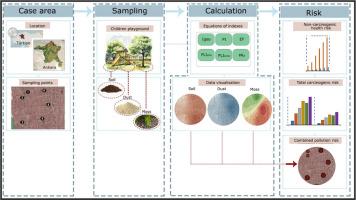评估城市儿童游乐场的重金属污染:土壤、灰尘和苔藓生物积累的比较分析
IF 6.3
2区 环境科学与生态学
Q1 ENVIRONMENTAL SCIENCES
引用次数: 0
摘要
有毒重金属是无处不在的环境污染物,可对人类健康,特别是儿科人群产生不利影响。本研究调查了Çankaya区6个城市儿童游乐场(公园1 ~ 6)土壤、粉尘和苔藓的重金属(Cr、Cu、Cd、Ni、Pb和Zn)污染情况。公园粉尘中Cu (44.1 mg/kg)、Ni (45.6 mg/kg)和Pb (44.2 mg/kg)的含量最高。苔藓样品Cr和Zn含量较高,分别为68.7 mg/kg和284.3 mg/kg。其中表层土壤中锌含量最低,最高为259 mg/kg,最低为1.9 mg/kg。苔藓的总金属负荷最高Σ=482.1 mg/kg,其次是粉尘Σ= 457.9 mg/kg,土壤Σ= 3 88.3 mg/kg。土壤与其他样品类型之间p <; 0.05差异显著,R2 = 0.9443的强相关性表明,苔藓金属浓度受自然和人为来源的影响,包括湿沉降和干沉降。空间分析显示,Cr和Cu在交通区域的集中程度较低。在远离车辆交通和污染土地用途的公园(公园1和公园2)中,浓度存在显著差异,浓度较低。主成分分析(PCA)和正矩阵分解(PMF)确定了四种排放源:柴油燃烧、交通运输和化石燃料燃烧,这些排放源被运输到离其源数公里远的地方,并通过大气沉积转移到土壤中。富集和生物富集因子表明,粉尘中镉富集程度较高,苔藓中镉富集程度显著。污染指数各不相同,园区受到车辆交通的压力,商业和工业区(园区6)的污染最高。这些地方调查结果使人们注意到较低规模的土地使用决定对人类,特别是儿童健康风险的显著影响。本文章由计算机程序翻译,如有差异,请以英文原文为准。

Assessing heavy metal pollution in urban children’s playgrounds: Comparative analysis of soil, dust, and moss bioaccumulation
Toxic heavy metals are ubiquitous environmental contaminants that can detrimentally influence human well-being, especially in the pediatric population. This study investigated soil, dust, and moss contamination collected from six urban children’s playground (parks 1 to 6) in Çankaya District with heavy metals (Cr, Cu, Cd, Ni, Pb, and Zn). The highest values of Cu (44.1 mg/kg), Ni (45.6 mg/kg), and Pb (44.2 mg/kg) were recorded from park dust. Moss samples showed higher values of Cr and Zn, respectively, as 68.7 mg/kg and 284.3 mg/kg. Of these, surface soil presented the lowest concentrations, with Zn showing the highest concentration at 259 mg/kg and Cd the lowest at 1.9 mg/kg. Moss showed the highest total metal load Σ=482.1 mg/kg, followed by dust Σ = 457.9 mg/kg and soil Σ =3 88.3 mg/kg. Significant differences of p < 0.05 between the soil and other sample types, together with a strong correlation of R2 = 0.9443, may indicate that moss metal concentration is influenced by natural and anthropogenic sources by wet or dry deposition. Spatial analysis revealed metal hotspots near roadways, with Cr and Cu less concentrated in traffic areas. Significant variability was noted across parks, far from vehicular traffic and polluting land uses (parks 1 and 2), showing lower concentrations. Principal component analysis (PCA) and positive matrix factorization (PMF) identified four emission sources: diesel combustion, transportation, and fossil fuel combustion, which are transported up to several kilometers away from their sources and transferred to the soil by atmospheric deposition. Enrichment and bioaccumulation factors highlighted high Cd enrichment in dust, with significant bioaccumulation in mosses. Pollution index values varied, with parks under the pressure of vehicular traffic, commercial and industrial zones (park 6) showing the highest contamination. These local findings draw attention to the striking impact of land use decisions at a lower scale on the health risks of humans, especially children.
求助全文
通过发布文献求助,成功后即可免费获取论文全文。
去求助
来源期刊

Journal of Environmental Sciences-china
环境科学-环境科学
CiteScore
13.70
自引率
0.00%
发文量
6354
审稿时长
2.6 months
期刊介绍:
The Journal of Environmental Sciences is an international journal started in 1989. The journal is devoted to publish original, peer-reviewed research papers on main aspects of environmental sciences, such as environmental chemistry, environmental biology, ecology, geosciences and environmental physics. Appropriate subjects include basic and applied research on atmospheric, terrestrial and aquatic environments, pollution control and abatement technology, conservation of natural resources, environmental health and toxicology. Announcements of international environmental science meetings and other recent information are also included.
 求助内容:
求助内容: 应助结果提醒方式:
应助结果提醒方式:


